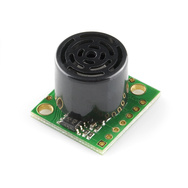Physics Lab 1
I asked physics teacher John Burk for advice on putting together labs for homeschooling my son in calculus-based physics using the Matter and Interactions book (see School decisions part 3 on the decision to homeschool). He was kind enough to pass on my request to the readers of his Quantum Progress blog: The ideal lab experience for a homeschooled student. He also gave me a suggestion for a piece of lab equipment we could use for a number of experiments in Newtonian mechanics: an ultrasonic rangefinder.
This post is my first attempt at a physics lab assignment for my son. (Note: we are also hoping to use tech writing this year to satisfy some of his English requirements, so the assignment is a bit heavier on the writing than might otherwise be appropriate for a physics class.) The exploration in this lab is more engineering than physics, but familiarity with measuring tools is a good place to start, I think.
I welcome feedback and suggestions, particularly from those who have taught physics!
Lab 1: ultrasonic range finder
Prelab
Research how an ultrasonic range finder works (note: as of 25 Aug 2011, the Wikipedia article is a terrible stub—other sources will be needed).
Write: Write a paragraph or two explaining how an ultrasonic rangefinder works. This should be at a reading level and level of detail suitable for replacing the current Wikipedia stub. Explain what determines the precision, accuracy, and range of the range finder. How frequently can it measure the range? How is the speed of sound involved? What does that depend on … ? Why do some have one transducer and others have two? Audience: new robotics club members (technically interested high school students without prior knowledge of physics or electronics).
Bonus audience: if the writeup is good, it can replace the current Wikipedia stub.
Read the product information (and data sheets when possible) for at least 3 different (cheap) range finding modules like the following three four (added one more 1 Sept 2011):
- PING))) ultrasonic range finder(Note: parallax.com also has mounting brackets, servo-mount option for panning, and packages that combine the range finder with other sensors.)
- SRF04
- MaXBotix LV-EZ1, other MaXBotix range finders
- VEX ultrasonic range finder
Choose one of the range finders for us to buy.
Write: justify the choice in writing, doing a comparison of the advantages and disadvantages of each choice. Give URLs as citations for data used in making the choice.
Sketch out in pseudocode the program needed to read the sensor on the Arduino using a simple busy loop. What will determine the precision and sampling rate of the measurements? What will the code do if there is no object in range of the sensor?
Advanced option: sketch out pseudocode for using interrupts instead of a busy loop.
The Lab Proper
- Hook up the rangefinder to the Arduino and program the Arduino to keep taking measurements and reporting them to the serial line.
- Calibrate the sensor by placing it at carefully measured distances from a hard wall and recording the readings. Repeat at several different distances. (Record temperature, humidity, and barometric pressure, if possible.)
- Plot the sensor readings vs. the actual distance.
- Do linear regression to get predictor of actual distance given sensor reading. (Caveat: need to plot distance vs. readings rather than readings vs. distance to get best fit for calibration.)
- Modify Arduino code to use the calibration parameters to provide better distance measurements.
- Re-calibrate using new code. What is the accuracy and precision of the measurements? What range of distances can be measured? Is the accuracy better expressed in terms of absolute error (±1cm, for example) or relative error (±5%, for example)?
- Open-ended: Experiment with detecting different targets (maybe flat targets from wall size down to the size of a quarter, maybe targets of different materials, maybe spherical targets). What effect does target size, shape, material, … have on range and accuracy of the measurement?
Tagged: Arduino, engineering education, Matter and Interactions, physics, rangefinder, science education, ultrasonic sensor

[original story: Gas station without pumps]





